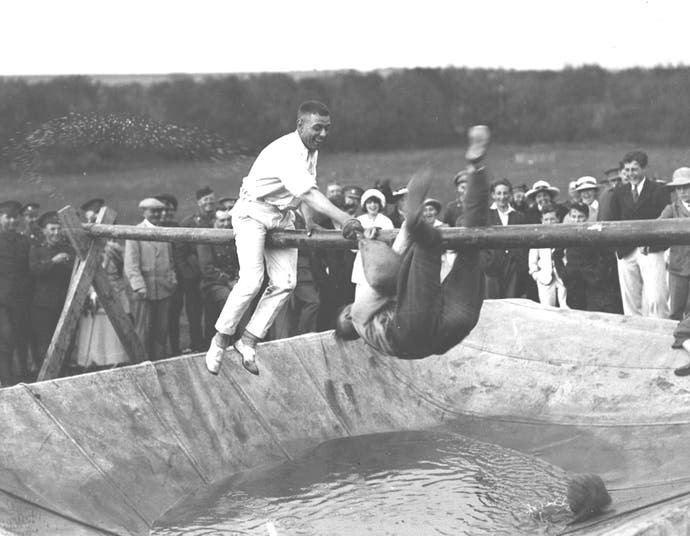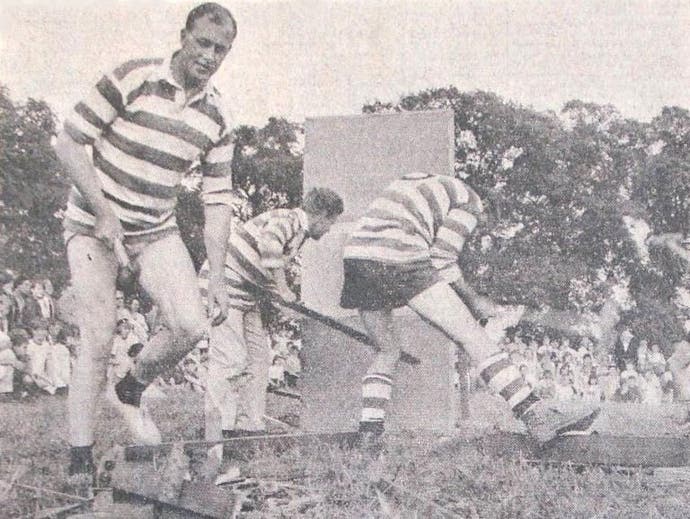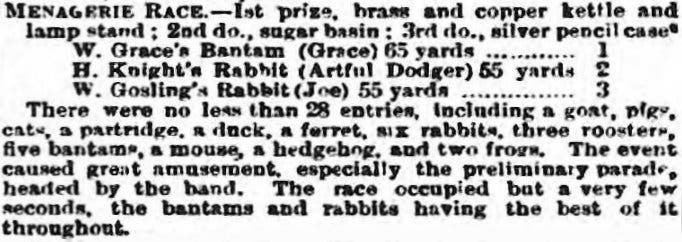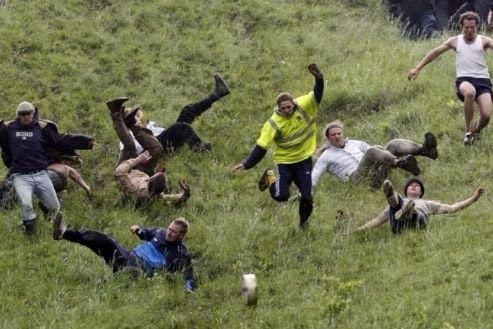Local sports used to be really weird
From piano bashing to menagerie races.
Hello! Chris Donlan here. Simon Parkin and I recently attended a wonderful talk at Brighton's Catalyst Club, in which historian Mathew Homewood picked over some of the strangest sports in Sussex history. I think it's quite interesting to think of games as being related to this quirky lineage, and so I asked him to write a bit about bizarre and forgotten sports for Eurogamer. I really hope you enjoy it.
Most of us have participated in those classic sports day events; the egg and spoon race, the sack race, and the tug of war. Relatively 'normal' activities for both children and adults. However, many years ago, grown men and women were participating in far more weird and unusual sporting events. The county of Sussex appears to have been one of the leading lights in this world of bizarre sporting behaviour. In Brighton's Royal Gardens, as far back as the 1820s, one could witness such events as climbing the greasy pole, grinning through horse collars, catching a cock 'with hands tied behind'(!), and jingling matches, which involved a man with a bell round his neck being chased around a field by an army of men with blindfolds. An experienced jingler may lead these men into a merry game of cat and mouse. However, one might have some sympathy for the inexperienced jingler, cantering around a field, jangling away, and being bundled over by an excited mob.
The greasy pole was often used in village sports days. A vertical pole, standing upwards of three meters would be coated with grease. A prize would then be placed at the top - sometimes a hat, but more often a leg of mutton - and crowds would watch enthusiastic, and often hopeless attempts to gain the prize. Another use for the greasy pole was to lay it vertically over a pit of cold water, sit two men on it, arm them will sacks full of something heavy, and let them battle it out until one (or both) fell into the water.

The early part of the twentieth century saw annual sports days held in hundreds of villages across Sussex. Many of the sports and games played at these events had far more ambiguous titles, and we might only hazard a guess at what they exactly entailed. At Sedlescombe in 1922, for instance, the villagers participated in 'cleaving the Turk's head', and 'catch the train'. At Framfield the following year 'musical eggs' and 'the lover's rescue' featured in the day's events. And at Bodle Street's Silver Jubilee celebrations in 1935 they held a 'cigarette race'. Another event here was the nail driving competition, which was won by Mrs Luck; clearly a woman who was handy with a hammer!
Another popular event, especially in the 1960s and 70s, was piano bashing! Back in the early half of the century, even modest households would often own a piano. However, by the 1960s many families came to realise that no one actually played the thing anymore, and thus there was an abundance of unwanted pianos in the country. So along came piano bashing.

The competitors would be provided with a piano, and also a wooden box with a small, rectangular hole in the top. The idea was to get the piano in the box. Armed with hammers, mallets, and whatever else they could lay their hands on, the competitors would set about the piano with a vigour. The first team to get their entire piano into the box were proclaimed the winners.
All these weird and unusual sports were perhaps nothing compared to the popular and highly amusing event that was the menagerie race. These appear to have originally been events practised by the army, creating 'considerable merriment'. One of the earliest references to a menagerie race is featured in a newspaper report from 1881, when at an event in Colchester, soldiers of the Queen's Own Royal West Kent Regiment were required to 'drive some animal or some bird (without cruelty)' along a measured course. These animals were of a wide variety; dogs, cats, rabbits, pigs, turkeys, geese and sheep all featured in this bizarre race, and the bulk of them could not be coerced into completing the full distance of the race (or sometimes even starting it). At an event at Powis Castle Park the same year, Lieutenant Evans' rat won the menagerie race. This was followed by Captain Apperley's pigeon, with Lieutenant Anwyl's goose coming in third.
In the Sussex county town of Lewes in 1888, a menagerie race was part of the entertainment in the sports day arranged by the Lewes Battery of Sussex Artillery Volunteers, and again reveals an eclectic mix of animals. The race consisted of a goat, a partridge, a duck, pigs, cats, a ferret, six rabbits, three roosters, five bantams, a mouse, a hedgehog and two frogs. Hens appear to have been ideal for these races, and were often the victors. In this particular instance, a bantam called 'Grace' won the event.

By the late 1880s menagerie races were a regular feature at village sports days, and none more so than in Sussex, with newspaper articles on this 'sport' revealing more held here than in any other county. Some of the most amusing events occurred in the small village of Barcombe. At their annual sports day, a 300-yard course was laid out, with each type of animal receiving a specific handicap. Cats and rats, for example, were given a 100 yard head start, and ducks and guinea pigs a 250 yard start. In the 1889 event, Poupart's dog won the race, with Chatfield's dog coming in second. Third was a cat 'driven' by McCarthy, and Sir William Grantham 'piloted' a turkey!
The races must have often been disrupted by fights among various entrants. It is highly likely the dogs would have been more interested in chasing the cats, rabbits and hens rather than competing in the race itself. At Windmill Hill in 1903, dogs and cats were excluded from the competition, yet a fox and a pheasant competed. One wonders if the pheasant survived.
An eclectic mix of animals would certainly have added to the amusement of the events. However, of all the unusual entrants to the menagerie races over the years, perhaps the award for the most bizarre should go to the Barcombe village sports day of 1893, when somebody entered.... a wasp!








